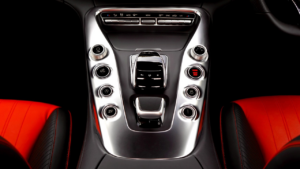If you’re in the market for a new vehicle, you’ve probably come across the terms ‘all-wheel drive’ (AWD) and ‘four-wheel drive’ (4WD). While they may seem similar, there are actually some significant differences between the two. Understanding these differences can help you make an informed decision when choosing your next car.
First, it’s important to understand how each system works. AWD is a system that distributes power to all four wheels of a vehicle, constantly adjusting the amount of power sent to each wheel based on the driving conditions. 4WD, on the other hand, is a system that sends power to all four wheels simultaneously, typically used for off-road driving and harsh terrain.
In this article, we’ll explore nine key differences between AWD and 4WD, including their traction capabilities, handling and control, fuel efficiency, and maintenance requirements.
What is All-Wheel Drive (AWD) and How Does it Work?
Get ready to learn about AWD and how it functions to provide superior performance on the road. All-wheel drive is a system that distributes power to all four wheels of a vehicle, allowing for better traction and control in various driving conditions.
This system is designed to work automatically, sending power to the wheels that have the most grip on the road. In an AWD system, the vehicle’s computer detects the amount of grip available on each wheel and adjusts the power distribution accordingly.
This means that if one wheel is slipping, power will be sent to the other three wheels to compensate. AWD is particularly useful in challenging driving conditions such as rain, snow or ice, where the extra traction can help keep the vehicle stable and on course.
It also provides a smoother ride and improves handling, making it a popular feature in many modern vehicles.
What is Four-Wheel Drive (4WD) and How Does it Work?
In this section, we’ll delve into how 4WD functions and gain a better understanding of its inner workings.
Four-wheel drive, as the name suggests, powers all four wheels of a vehicle. It’s a system that’s typically found in trucks and SUVs, and is designed to provide traction and power to all four wheels simultaneously, regardless of the terrain.
When you engage 4WD, the power from the engine is sent to a transfer case, which distributes it equally to both the front and rear axles. This means that all four wheels are working together to move the vehicle forward.
This is especially useful in off-road situations, where you need all the traction you can get to navigate rough terrain. However, it’s important to note that 4WD should only be used when necessary, as it can negatively impact fuel economy and handling on paved roads.
Differences in Traction Capabilities
You’ll notice a significant variation in how well your vehicle grips the road depending on whether you’re traversing slippery terrain or driving on a smooth surface. This is where the differences in traction capabilities between all-wheel drive (AWD) and four-wheel drive (4WD) become apparent.
Here are some points to consider:
-
AWD systems are designed to provide better traction on all types of surfaces, including dry, wet, and slippery roads. They work by sending power to all four wheels simultaneously, which helps to distribute torque evenly for better grip. AWD systems are typically found in cars, crossovers, and SUVs, and are ideal for drivers who want a vehicle that can handle a variety of weather conditions.
-
4WD systems, on the other hand, are designed for off-road use and are more suited for vehicles such as trucks and SUVs that are used for heavy-duty work. 4WD systems are typically engaged manually by the driver and send power to all four wheels at once, making them ideal for situations where maximum traction is needed.
However, because 4WD systems are designed for off-road use, they can be less efficient on smooth, paved roads and can sometimes cause excess wear and tear on the vehicle.
Differences in Handling and Control
When it comes to handling and control, there are some key differences between all-wheel drive (AWD) and four-wheel drive (4WD) vehicles.
With AWD, power is distributed to all four wheels automatically, providing better traction and stability on slippery roads.
On the other hand, 4WD vehicles typically have a low-range transfer case that allows for more torque and better handling off-road.
Understanding these distinctions can help you choose the right vehicle for your needs and ensure optimal performance in different driving conditions.
AWD Handling and Control
To truly understand how your vehicle handles and responds on the road, it’s important to consider the nuances of AWD control and how it differs from other common drivetrain options. AWD systems are designed to provide power to all four wheels of the vehicle, which can improve traction and handling in a variety of driving conditions.
Here are some key points to keep in mind when it comes to AWD handling and control:
- AWD systems can vary in their design and functionality, with some providing more power to the front or rear wheels depending on the situation.
- AWD can help improve acceleration and stability on slippery or uneven surfaces, such as snow, ice, or gravel.
- AWD can also help improve cornering and handling on dry roads, as it can distribute power to the wheels with the most grip.
- However, AWD systems can add weight and complexity to a vehicle, which can impact fuel efficiency and handling in certain situations.
It’s important to understand how your specific AWD system works and how to use it effectively in different driving conditions to get the most out of your vehicle’s handling and control capabilities.
Overall, AWD can be a valuable tool for improving your vehicle’s handling and control in a variety of driving situations. By understanding the nuances of AWD control and how it differs from other drivetrain options, you can make informed decisions about how to use your vehicle’s capabilities to your advantage on the road.
4WD Handling and Control
The section on handling and control of WD systems provides valuable insights into optimizing your vehicle’s performance on the road. When it comes to handling and control, the main difference between all-wheel drive and four-wheel drive lies in their power distribution. While AWD systems are designed to distribute power to all four wheels equally, 4WD systems can usually be manually adjusted to distribute power differently between the front and rear axles. This means that 4WD systems are generally better suited to off-road driving, where you might need to engage low-range mode for extra torque, or lock the front and rear axles for better traction on uneven terrain.
However, it’s important to note that both AWD and 4WD systems can offer excellent handling and control on the road, so long as they are properly maintained and used within their intended parameters. To help you make an informed decision about which system is right for your needs, we’ve put together a table comparing the key characteristics of each type of system. While this table is by no means exhaustive, it should give you a good starting point for understanding the differences between AWD and 4WD systems and what each has to offer.
| Type of System | Power Distribution | Traction Control | Ideal for |
|---|---|---|---|
| AWD | Equal power to all four wheels | Automatic | On-road driving, inclement weather |
| 4WD | Adjustable power distribution between front and rear axles | Manual (usually) | Off-road driving, heavy-duty towing |
Differences in Fuel Efficiency
AWD tends to be more fuel efficient compared to 4WD due to the way power is distributed to the wheels. AWD vehicles typically use a system that only sends power to the wheels that need it, which means that power is not wasted by sending it to wheels that do not require it.
In contrast, 4WD vehicles distribute power equally to all four wheels, which can lead to wasted energy and reduced fuel efficiency.
The difference in fuel efficiency between AWD and 4WD vehicles may not be significant in some cases, but it can be noticeable when driving in certain conditions. For example, if you frequently drive in city traffic or on paved roads, an AWD vehicle may be a better choice for you if fuel efficiency is a concern.
However, if you frequently drive off-road or in extreme weather conditions, a 4WD vehicle may be a better option, even if it is less fuel efficient.
Ultimately, the choice between AWD and 4WD will depend on your specific needs and priorities.
Differences in Maintenance and Repairs
Maintaining and repairing vehicles with AWD or 4WD systems can pose unique challenges and expenses. Both systems require regular maintenance to ensure they function properly.
AWD systems have a more complex design, with multiple differentials and transfer cases, which can make repairs more difficult and expensive. Additionally, the added weight and complexity of the AWD system can cause more wear and tear on parts, resulting in more frequent repairs.
4WD systems, on the other hand, are simpler in design and typically require less maintenance. However, because they are often used in off-road vehicles, they may require more frequent repairs due to rough terrain and heavy usage. The differential and transfer case in a 4WD system are also more exposed to the elements, which can cause them to wear out more quickly.
Overall, both AWD and 4WD systems require regular maintenance and repairs to ensure they function properly, but AWD systems may be more complex and expensive to repair.
Advantages and Disadvantages of AWD
You might be surprised to learn about the pros and cons of having an AWD system in your vehicle. Here are some advantages and disadvantages to consider:
-
Advantages:
-
Better traction and handling in slippery or uneven road conditions
-
Improved performance in off-road situations such as mud, sand, or gravel
-
Generally safer for driving in inclement weather compared to two-wheel drive vehicles
-
Disadvantages:
-
More expensive to purchase and maintain compared to two-wheel drive vehicles
-
Increased weight can lead to decreased fuel efficiency
-
More complex system with more parts, which can increase the likelihood of mechanical issues
Before deciding whether or not to opt for an AWD system in your vehicle, it’s important to weigh the benefits and drawbacks. While it may provide better handling and performance in certain situations, it also comes with added costs and potential maintenance issues. Ultimately, the decision should depend on your specific driving needs and preferences.
Advantages and Disadvantages of 4WD
If you’re looking for the ultimate off-road experience, 4WD might just be the solution you’ve been searching for. With 4WD, power is distributed evenly to all four wheels, making it easier to navigate through harsh terrain. This is especially useful when driving through mud, snow, and rough terrain.
4WD also provides better traction and stability, which is essential for off-road adventures. However, 4WD does have its disadvantages. It can be more expensive to purchase and maintain than AWD. Because all four wheels are constantly engaged, it uses more fuel than AWD.
Additionally, 4WD is not ideal for everyday driving as it can cause unnecessary wear and tear on the vehicle. Overall, 4WD is a great option for those who frequently go off-road, but it may not be the best choice for everyday use.
Frequently Asked Questions
Can you switch between AWD and 4WD while driving?
If you’re wondering whether you can switch between AWD and 4WD while driving, the answer is that it depends on the specific vehicle. Some vehicles allow you to switch between AWD and 4WD while driving, while others require you to come to a complete stop before making the switch.
It’s important to consult your vehicle’s owner’s manual to understand the specific requirements for switching between AWD and 4WD. Additionally, it’s important to remember that switching between AWD and 4WD can cause wear and tear on your vehicle’s drivetrain, so it’s best to only make the switch when necessary and according to the manufacturer’s recommendations.
How does AWD/4WD affect a vehicle’s towing capacity?
If you plan on towing heavy loads, it’s important to understand how all-wheel drive (AWD) or four-wheel drive (4WD) can affect your vehicle’s towing capacity.
In general, AWD and 4WD vehicles tend to have higher towing capacities than their two-wheel drive counterparts. This is because the additional wheels provide more traction, which can help with acceleration and stability when towing.
However, it’s important to note that not all AWD or 4WD vehicles are created equal in terms of towing capacity. Factors such as the vehicle’s weight, engine power, and transmission type can all play a role in determining how much weight it can safely tow.
It’s always best to consult your vehicle’s owner’s manual or a professional mechanic to determine the maximum towing capacity for your specific make and model.
Is it necessary to have AWD or 4WD for driving in snowy or icy conditions?
If you frequently drive on snowy or icy roads, having all-wheel drive or four-wheel drive can be beneficial. These systems provide additional traction and stability, which can help you maintain control of your vehicle in slippery conditions.
All-wheel drive is typically better for everyday use on slippery roads, as it automatically adjusts to changing conditions. Four-wheel drive is better for off-roading, as it allows you to manually select different modes depending on the terrain.
Ultimately, whether or not you need all-wheel drive or four-wheel drive depends on your personal preferences and driving needs. However, if you frequently encounter snowy or icy roads, it’s worth considering investing in one of these systems to help keep you safe on the road.
How do AWD and 4WD systems affect a vehicle’s acceleration and braking?
When it comes to acceleration and braking, both all-wheel drive (AWD) and four-wheel drive (4WD) systems can have an impact on a vehicle’s performance. Generally speaking, AWD systems tend to provide better grip and traction on slippery surfaces, which can help to improve acceleration and reduce stopping distances.
4WD systems, on the other hand, are often designed with off-road driving in mind, and can provide additional torque to all four wheels to help climb steep inclines or traverse rough terrain.
Ultimately, the effectiveness of both AWD and 4WD systems will depend on a variety of factors, including the specific design of the vehicle, the condition of the tires, and the nature of the driving conditions themselves.
Are there any hybrid or electric vehicles that offer AWD or 4WD options?
If you’re in the market for a hybrid or electric vehicle with all-wheel drive or four-wheel drive, there are several options available.
One popular option is the Toyota RAV4 Hybrid, which offers all-wheel drive and impressive fuel efficiency.
Another option is the Ford Escape Hybrid, which offers both all-wheel drive and four-wheel drive options.
Additionally, the Tesla Model S and Model X both offer dual motor all-wheel drive as a standard feature.
It’s important to note that while all-wheel drive and four-wheel drive can provide better traction and handling in certain driving conditions, they can also add weight and reduce overall fuel efficiency.
Conclusion
Now that you know the differences between all-wheel drive and four-wheel drive, you can make an informed decision on which type of vehicle is best for your needs.
AWD offers better traction in all weather conditions and provides a smoother ride, while 4WD is better for off-roading and towing heavy loads.
When it comes to handling and control, AWD is better for everyday driving on paved roads, while 4WD is better for navigating through rough terrain.
AWD also tends to be more fuel-efficient than 4WD, but it may require more maintenance and repairs due to its complex system.
Ultimately, it all depends on your personal preferences and driving habits. Consider your needs and make the best choice for your lifestyle.































































































